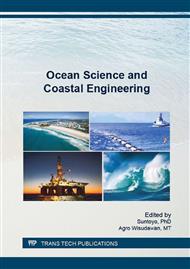p.284
p.291
p.296
p.302
p.308
p.315
p.321
p.326
p.332
Numerical Model for Prediction the Scour Depth around Two Pipelines in Tandem
Abstract:
Scour around submarine pipelines is one of the factors that affecting their stability which need to be considered. There have been several experimental investigations on scour depth. Although many studies have been conducted to investigate scour below a single pipeline, the effects of the spacing between two pipelines on scour characteristics are not properly understood. This study is focused to investigate the effects of pipeline diameters (D), gap ratio (G/D) between the pipelines, and the Reynolds Number (Re) on the scour depth. Simulations are conducted for two pipelines with diameters 0.075 m and 0.1 m, where the gap ratio is , , and . In case the pipeline diameter, , it is found that the relative scour depth increases with increasing the gap ratio, where and are upstream and downstream pipeline diameters, respectively. Meanwhile, when , the scour depth decreases with decreasing the gap ratio. For the gap, , the scour depth is smaller than at the gap and due to the disturbance of the vortex shedding around the upstream pipeline.
Info:
Periodical:
Pages:
332-337
Citation:
Online since:
January 2017
Authors:
Keywords:
Price:
Сopyright:
© 2017 Trans Tech Publications Ltd. All Rights Reserved
Share:
Citation:


